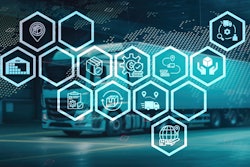
*This content is sponsored by SAP*
“You think? You think? Your machine is supposed to do the thinking, Jetson!”
Those words, uttered by George Jetson’s boss, Cosmo Spacely, in the 1960s cartoon sitcom, ring true today, as more than ever our modern global supply chain is facing a massive transformation at the hands of AI and ML (artificial intelligence and machine learning, respectively).
In a recent webinar hosted by Supply & Demand Chain Executive titled, “Navigating the Future: Transforming Supply Chain Networks through Digital Innovation,” a panel of experts from MIT and SAP discussed the market opportunities and use cases for AI adoption in today’s supply chain and logistics industry. What follows is a brief synopsis of the discussion.
Three Key Takeaways
AI and ML have recently drawn increased interest in business circles, especially in the retail and consumer sectors, but more and more in the supply chain, as advanced automation and robotics take hold in warehouse settings worldwide.
Kellen Betts, Course Lead and Research Project Manager for MIT Center for Transportation and Logistics, and Stanford Huynh, Business Network Director at SAP, shared with discussion moderator, Corey Hughes, SAP Regional Director, their insights on the topic. Of note, three points indicate that AI and ML are here to stay, and any company prepared to adopt the technology will stand to benefit.
POINT 1: AI Adoption Is Accelerating
While AI and ML are in the early stages of adoption in the global supply chain, interest in the technology has accelerated, as evidenced by poll results shared during the webinar. Of the webinar participants responding to the question, “which best describes your company’s strategy regarding AI/ML?”, 50 percent of respondents said they already have substantial AI capabilities in use and have documented benefits, while 50 percent said they have plans to deploy AI-enabled tools in the future.
“This is not a fad,” said Betts, whose research includes omnichannel distribution and supply chain sustainability initiatives. “Two areas show promise for the use of AI in supply chains. First, knowledge workers have a rapidly expanding quiver of new tools to use with the acceleration of generative AI technologies in the last year. Second, there are both established and emerging AI applications to streamline operations, such as more advanced forecasting and final-mile vehicle routing.”
Of course, data management will play a major role in the effectiveness of any AI/ML application. As with most digitally enabled innovations, output depends heavily on having timely access to quality information up front. This is often a challenge in supply chains where data is stored in modern ERPs, warehouse, transportation, and labor management systems, and traditional spreadsheet workflows. Establishing robust data pipelines to prepare this data for AI-enabled applications is essential.
POINT 2: AI Use Cases Are Expanding
Widespread adoption of generative AI has refined its use in modern supply chain networks, making the technology especially suitable for service operations, wherein customer communication and self-service are critical to the user’s experience. Generative AI employs advanced algorithms to sift vast amounts of historical and streaming data to compose text, images, and other media that display human characteristics. “The machine” actually does “the thinking for you, Jetson!”
What’s more, as ML models increasingly learn the patterns of response over time, the machine gets smarter with every wave of feedback. AI/ML models have been developed for a host of supply chain applications, including:
- Stock in transit
- Visual inspections
- Demand forecasting and sensing
- Project cost prediction
- Predicted delivery processing
- Demand-driven replenishment
- Forward scheduling
- Field service scheduling
- Asset prediction and optimization
- Slow-moving materials prediction
- As well as finance, customer experience, procurement, human resources, and IT scenarios
According to Huynh, SAP embeds AI into an organization’s applications and business processes and allows companies “to automate business processes, achieve business outcomes, make better data-driven decisions, and allow people in an organization to focus on tasks that really matter.”
POINT 3: Supply Chain AI Is a Work In Progress
There are many providers already developing tools for improving supply chain operations. Low-hanging fruit includes predictive analytics, where demand forecasts based on historical data and seasonal industry averages are reducing inventory on hand and informing labor schedulers on appropriate staffing levels.
Last-mile routing is another emerging application. Based on satellite tracking and expert driver records, AI/ML solutions are helping solve challenges in urban final-mile delivery, such as parking, traffic, weather, day-parts, and population densities to enhance cost savings, reduce emissions, and prolong asset life.
“We’re just now scratching the surface,” said Huynh, whose focus at SAP is developing technological solutions that help companies run better. “Finding ways for partners to share data across the network is critical to ensuring resilience moving forward.”
According to Betts, “It’s also a business ecosystem challenge. AI-powered applications can make predictions in real-time, which can provide the agility to avert a disaster rather than being crippled by an unplanned disruption. However, these applications are ultimately based on data that often needs to be shared between business partners across the supply chain network.”
As AI/ML tools continue to improve, machines will continue to do more of the thinking, so that humans can focus on strategies that make the world run better and enhance people’s lives. To learn more about today’s AI-powered supply chain, please visit Supply & Demand Chain Executive now.





![Top Tech Logo Vertical [color]](https://img.sdcexec.com/files/base/acbm/scn/image/2023/12/top_tech_logo_Vertical__color_.656e286049642.png?auto=format%2Ccompress&fit=crop&h=167&q=70&w=250)
![2023 Top Software Color[vertical]](https://img.sdcexec.com/files/base/acbm/scn/image/2023/10/2023_TopSoftware_color_vertical_.653a8505cd258.png?auto=format%2Ccompress&bg=fff&fill-color=fff&fit=fill&h=167&q=70&w=250)






